Introduction
Charles-Édouard Jeanneret-Gris, known under the pseudonym of Le Corbusier, is considered one of the most important and influential architects of the twentieth century. The design of Corbusier’s buildings and urban plans paved the way for numerous architects and sometimes bureaucrats, who took his ideas and therefore undermined the value that the former had. One of the unique characteristics of the architect’s work is the way in which nature was incorporated into his architecture. The example of the Villa Savoye represents this characteristic and embodies the five characteristics of New Architecture as envisioned by Le Corbusier – supports, gardens on the roof, the open-plan design, horizontal windows, and the free design of the façade.
These characteristics have developed in the architect’s style through the influenced that he had encountered in his education and the practice, including the Art Moderne and the Bauhaus schools as well as de-constructivism, structuralism, postmodernism, and brutalism. Thus, it can be hypothesized that the influence of Le Corbusier’s works on modern architecture was reflected in the five points created by the architect, the environmentalist approach to design, and the strive for simplicity.
The five points approach means that contemporary buildings are developed based on the principles that the architect pioneered in his work. The environmentalist perspective implies the combination of architecture and nature in a balanced way while they strive for simplicity is associated with the elimination of embellishments and fancy ornaments.
Background on the Architect
Born on October 6th, 1887 Charles-Édouard was showing artistic inclinations from his childhood. At age 15, he created a pocket watch that won the first prize at Turin’s International Exhibition of Modern Decorative, and only three years after that, he developed plans for his first piece of architecture. His study experience included the work with Auguste Perret who pioneered the use of reinforced concrete in residential architecture. The pseudonym of Le Corbusier was used in 1919 in an architectural magazine, L’Esprit Nouveau, in which he advanced the theories associated with the development of the Modern Movement, a school of architecture that emphasized the role of practicality instead of beauty.
Within the architectural framework that Le Corbusier pioneered, his ideal house had to be supported by a backbone made of reinforced concrete, the idea brought by his teacher, Perret. The house had to be raised from the ground with the help of pillars to protect the concrete from the damp ground. This feature went against all design possibilities that were possible in the traditional approach to buildings. Picture windows had to run from one end of the building to another had to invite the natural light to the interiors. The flat roof was intended to be topped with a garden; therefore, every detail in the ideal home created by the architect had to benefit the lives of those people who lived in it.
The idea of a perfect building transformed into life in the form of Le Corbusier’s most notable building, the Villa Savoye, which was built close to the architect’s specifications, including the furnishings and interiors (Figures 1-3). Every detail of the Villa reflected the Modern Movement while also representing a nod to the discipline of urban planning, which is the study of the organization in densely populated areas.
The Villa Savoye is considered the epitome of Le Corbusier’s work, with its modern take on a French country house that celebrates the new machine age. From the interior design to the garden rooftop, each component was carefully thought through in order to abandon the extra and the unnecessary aspects that could have burdened the composition despite adding to the beauty. However, in the case of Villa Savoye, beauty is found in simplicity, which is why it is among the most replicated buildings in modern architecture.
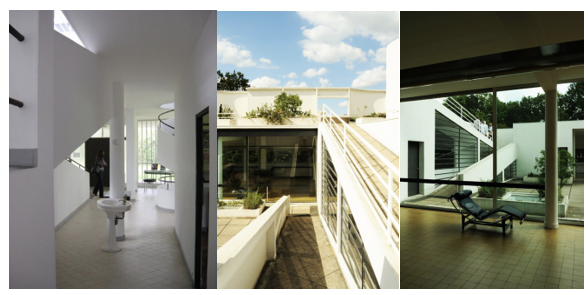
Villa Savoye: Analysis
Le Corbusier’s Villa Savoye is a representation of a purist approach to architecture: a “stark floating box pierced by symmetrical window openings” (Elam 2013, par. 2). The house is intentionally devoid of any additional decorations in order to ensure that the visual appeal is created through form rather than embellishments. The perfect geometrical composition is achieved through the interplay of the vertical pillars and the horizontal rectangle of windows, while the cylinders located on the roof offer a contrast to the structure’s right angles (Figure 4).
The overall pleasing proportions of the building are attributed to the harmony that Le Corbusier achieved in the development of the villa’s structural elements. If to analyze the building from the balanced perspective, a large circle can be drawn from post to post and touch the top of the building. Two smaller circles can be drawn from one edge to another and touch the tops of window openings.
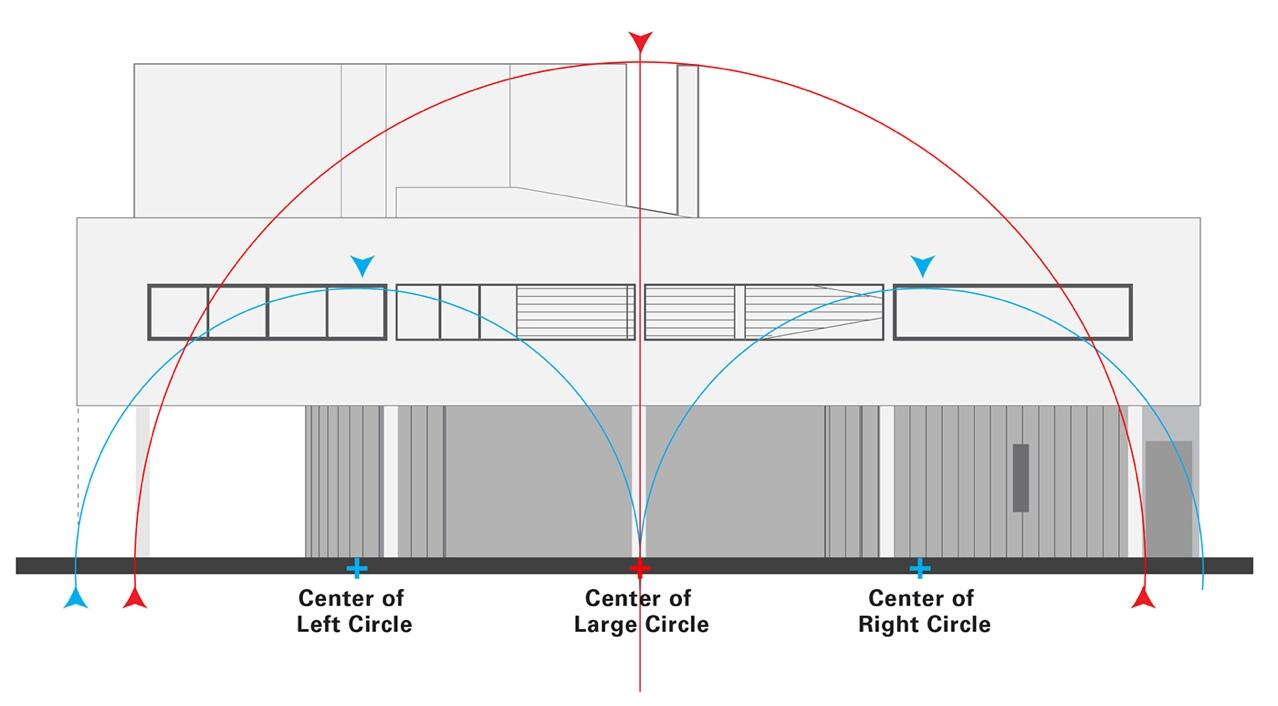
In terms of the building’s geometrical relationship to a square, several points should be mentioned. The rectangular structure of the house implies a division into small rectangles, including the front elevation and the extending structure on the roof. Also, the squares can extend to the pillars to the highest point of the house, with the centers of the square located at the break between the two openings of windows. The body of the house, which is resting on poles, can be described as made of six squares located side-by-side (Figure 5)
.
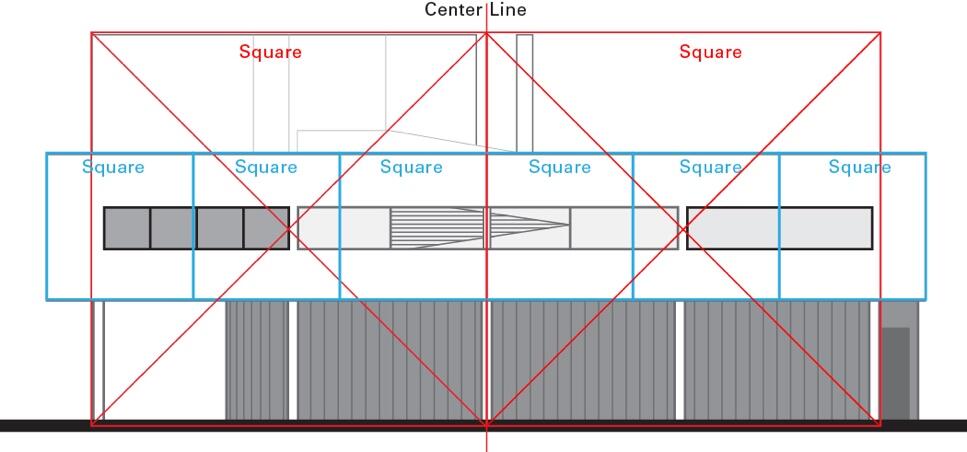
Overall, the geometric breakdown of Villa Savoye’s composition showed that the building is perfectly balanced in relation to both circles and rectangles. This shows that at the stage of projecting the Villa, the architect spent a lot of time and effort on ensuring that the structure follows the general principles of geometry. Thus, the ideal composition of the Villa offered ground for considering it a purist representation, in which every detail was considered as that contributing to the balance of the building. This perfect balance contributes to the recognition of Villa Savoye as the brightest example of modernist architecture. In its essence, the building represents everything for which Le Corbusier strived – to create a perfect piece of architecture, the legacy of which transcended decades.
Influence on Modern Architecture
Ecology and Sustainability
The concepts of ecology and sustainability inherent to Le Corbusier’s style today became buzzwords as the future of contemporary design has been intertwined with the considerations of the planet’s survival and prosperity. The architect invested in the development of a naturalistic idea of urban space was initially thought of as a deviation of his initial support for advanced technologies.
In his view, nature was considered a complementary aspect of technology and was filtered through the same perspective of positivism that Le Corbusier applied in regards to technologies. By the end of the 1920s, the architect found a powerful stimulus to combine the laws of natural sciences inherent to natural phenomena with the perfect geometry and balance present in his works. This effort has explained the aspect of functionality not only in terms of general hygiene and sustainable living but also in regards to the less academic analysis of the French city offered by geographers.
Knowing this, the technologies used by modern scientists include green roofs, photovoltaic cells new advancements of which no one had thought before. However, although green roofs may seem innovative, they were used back in the ’50s and 60’s by no other than Le Corbusier (Figure 6). Although in a different interpretation, the roof garden of Villa Savoye is a distinct feature of the architect’s style that has been replicated in a variety of contexts in modern architecture (Figure 7), as seen from the comparison of images below:

Importantly, the notion of sustainability that is known today did not exist during the time of modernism, but Le Corbusier still found the motivation to come up with environmentally-friendly solutions in design (Chan 2013). This can be attributed to the resource crisis in Europe, which led to fuel and wealth being considered precious. Modernist architectures of that time aimed to create designs for the class of people who were previously not accustomed to the architectural product, which was usually targeted to elite consumers. Therefore, despite the fact that modernist designers of the ’60s did not aim to protect global eco-systems as they do in 2018, they still aimed to have a less negative influence on the environment and promote the ideas of resource conservation.
Overall, Le Corbusier achieved a balance between his works from concrete and the natural aspect of the environment. Not only did it give a start for further explorations of environmentalism on the part of European architects but it also contributed to the artistic value of his work. The stark contrast between white concrete structures and the peaceful quality of nature is an architectural method used in multiple structures around the world and has been elevated to the highest possible degree, as seen from the following examples:

As seen from these examples, the synthesis between Modernist architecture and the landscapes of nature creates a synergy that cannot be explained by words. The influence of Le Corbusier is evident in these projects as considerations about the preservation of nature while contributing to the architectural heritage of modern designers and artists.
Simplicity and Utilitarianism
Apart from the notable ideas of environmental sustainability and the preservation of nature, the combination of simple forms and utilitarian needs also had a deep impact on modern architecture. After WWII ended, Le Corbusier gradually developed his own proportional system that became a standout component of his style. The spaciousness and simplicity in terms of form inherent to the Bauhaus were liberating to architects and contributed to the development of modern designs. According to the German designer Dieter Rams, products that are “reduced, clear, and user-oriented as possible are simply more bearable for a longer period of time” (Frearson 2017, para. 3).
These qualities are inherent to Le Corbusier’s style as he reduced his designs to include only the most important and distinct features (Figure 3) that are still considered relevant and notable today (Figure 4).

The evident replication of Le Corbusier’s Villa Savoye in the form of the Australian Institute of Aboriginal and Torres Strait Islander Studies represents the significance of the architect’s contribution to contemporary art. The philosophy of machine for living combined with immaculate and pure features has become crucial to modernist architecture. Even today, Le Corbusier’s Villa Savoye is called the house of the future despite being built several decades ago. Because of this, the remnants of the building can be seen in many modern pieces of architecture. To a great degree, one of the most famous works of the architect set the course for the design of buildings for the next hundred years, which points to the visionary nature of Le Corbusier’s work.
Le Corbusier himself wrote, “the religion of beautiful materials is in its final death agony… The almost hysterical onrush in recent years toward this quasi-orgy of décor is the only last spasm of a death already predictable” (Kohlstedt 2018, par. 3). This meant that the architect believed that the modern world of his time had evolved beyond any decorative frills. Because of this view, he promoted useful, well-developed, and designed things that would offer the aspect of utilitarianism not only in architecture but also in furniture and fixtures.
Their strive for simplicity was supported by other modernist schools of thought, such as Bauhaus, and Modernists like Adolf Loos who in his work, Ornament and Crime, wrote that “the evolution of culture marches with the elimination of ornament from useful objects” (Kohlstedt 2018, par. 4). Many prominent architects of that time would subsequently reject ornamentation in design in the strive for achieving sleek and minimalistic looks, the beauty of which will be kept in simplicity rather than complexity.
The abandonment of embellishments and decorations in his designs enabled the valuing of simplicity and utilitarianism in modern design. In particular, the traces of Le Corbusier’s simplistic approach to residential design are evident in the newly constructed townhouses seen in the image below. This particular house in Portland, Oregon is a representation of a blend of economy and simplicity. Although its owner, Nick Oakley, did not acknowledge the influence of Le Corbusier, his legacy is seen in the pillar-like structure of the ground floor with the large glass windows and the slightly protruding second floor, resulting in a T-shape that represents both simple and bold gesture (Libby 2016).
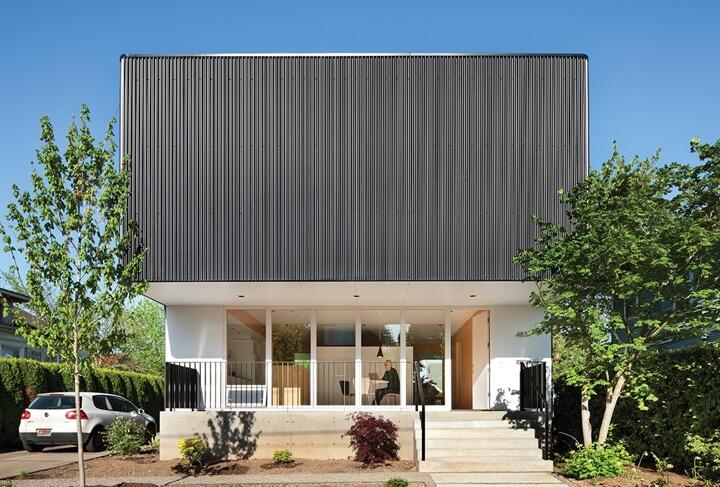
Five Points of Architecture
The influence of simplistic components in the architect’s designs is seen not only in the direct replications but also in the works of numerous modern architects who admitted Le Corbusier’s impact on their art. The five points of architecture can be traced in many modernist projects of the current day, including residential architecture. The five points formulated by the architect in 1926 and were intended to be used in French domestic architecture, with Maisons Citrohan (Figure) being the first attempt of the designer to deal with the issue of mass housing. All components of the house were united by a spatial continuum while the open space created by pillars along with the flat roof contribute to the increase of a small area.
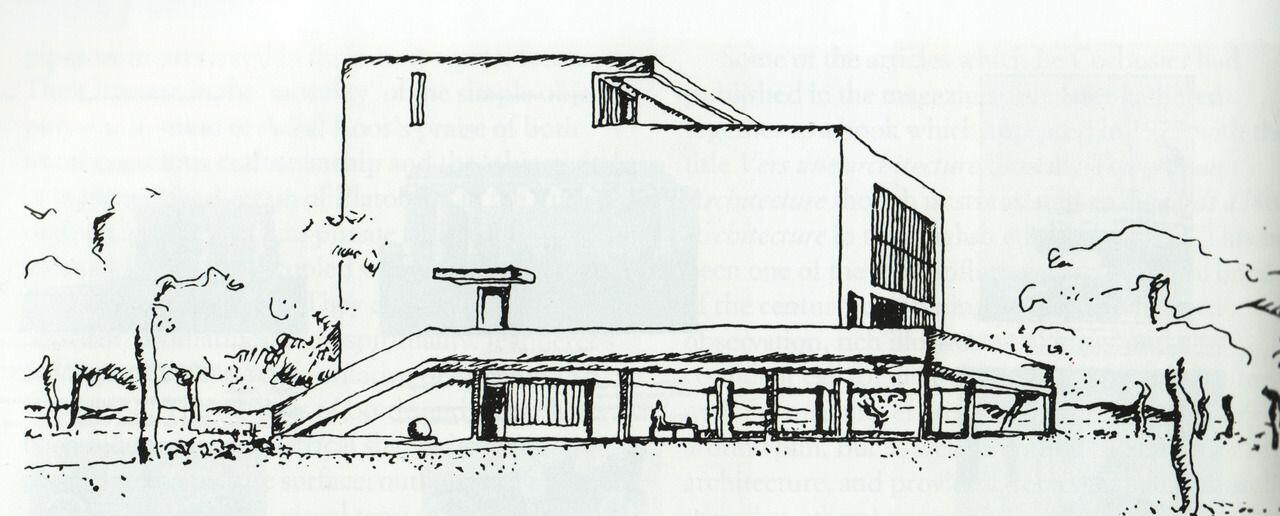
A modern example representing Le Corbusier’s five points in modern architecture is the Katanienbaum Twin houses (Figures 5-6) designed by Lussi and Halter Partner AG in Switzerland rest on thin black supports. Similar to its precursor, the house is accommodative of the dimensions of vehicles and integrates the machine-oriented models of living that Le Corbusier supported. The continuous glass façade of the ground floor makes inhabitants connect closely with the surrounding environment. Also, the black poles create an illusion of floating, which makes the building merge with the environment.
The concrete pool on the roof echoes the roof gardens through expanding the living from indoors to outdoors. In addition, depending on the adjustment of the wooden shutters, the terrace can become a part of either the outdoor or interior space, which is an aspect of Le Corbusier’s approach of mixing the two living areas into one. The property is located in a beautiful area with a lake and woodland areas with birch, oak, chestnut, and evergreen trees. The interplay between the concrete, glass, and metal of the house and the beauty of nature creates an ideal juxtaposition that played a defining role in the conception and the development of the project.

Another example of the significant influence of Le Corbusier is reflected in Pitch’s House designed by Iñaqui Carnicero Architects in Madrid, Spain (Figures 7-8). The first similarity is associated with the Corbusian approach to denying the immediate geographic context of the location, ignoring the rocky terrain, and favoring the distant skyline of the city that can be seen through the large windows. The plot of a project is characterized by having a great slope to the south, creating a house structure at both functional and formal levels. The underground level that can be seen to the left in the image is used to solve the issue of the land slope.
The open plan of the living space combined with the horizontal strip of windows, which is an integral part of Le Corbusier’s style, creates an impressive sight. In addition, the use of concrete surfaces represents another nod to the architect’s tendency for béton brut (Sorabjee n.d). The unique line of windows echoes the influence of Le Corbusier and allows for the trimming of the landscape as well as the illumination of the concrete ceiling. It is also important to mention that the building was developed with some economic restrictions, which led architects to establish solutions that generated attractiveness of the minimalist style.

Thus, the five points of architecture pioneered by Le Corbusier in his design represent a solid framework that was easy to follow for modern architects. Open plan designs, horizontal windows, a pillar supports, bringing the inside outside, and the free façade design can all be traced in the works of contemporary architects. In many ways, the five architectural points developed by Le Corbusier offered modern architects a broad ground for exploration, especially with the availability of new technologies, materials, and various construction solutions that were not available in the ’50s and ’60s.
Concluding Remarks
The influence of Le Corbusier on the shaping and development of contemporary architecture is undeniable. The traces of his impact are particularly evident in residential architecture, which can be explained by the fact that Le Corbusier focused on bringing the product of architecture to those people who could not previously afford it. As the architect applied his urban planning strategies in multiple cities around the world, his influence can be traced as far as Australia, with the building of the Australian Institute of Aboriginal and Torres Strait Islander Studies completely replicating the Villa Savoye but in a different color.
The combination of simplicity and utilitarianism, the five points of architecture, and the considerations for the environment represent three influences of Le Corbusier’s approach that contemporary designers employ to this day. The supporting pilotis (pillars), which represent the most notable characteristic of Le Corbusier’s design, have been seen in multiple examples of residential architecture and are expected to be used in future projects.
In addition, the horizontal line of big windows running across the façade has also been reflected in the examples of contemporary buildings. What is interesting to note is that the machine living philosophy supported by Le Corbusier has gained a new meaning in modern days with the help of such advancements as smart homes. Overall, the architect offered multiple opportunities for development in contemporary design, making his contributions fundamental to the history of global architecture.
Reference List
The architecture integrates nature. 2016, image. Web.
Chan, K 2013, Le Corbusier’s ecology: what modern architecture teaches us about green design. Web.
Contemporary office submersed in wilderness. 2013. Web.
Elam, K n.d., Corbusier’s Villa Savoye, geometric analysis. Web.
Frearson, A 2017, ‘Simplicity is the key driver to excellence’ says Dieter Rams. Web.
Katanienbaum Twin houses n.d. Web.
Kohlstedt, K 2018, Machine for living in: Le Corbusier’s pivotal ‘five points of architecture’. Web.
Kroll, A 2010, AD classics: Villa Savoye/Le Corbusier. Web.
Le Corbusier’s Villa Savoye n.d., image. Web.
Libby, B 2016, An industrial designer’s house blends economy and simplicity. Web.
Maison Citrohan n.d. Web.
Pitch’s House n.d.. Web.
Pyramid rooftop garden n.d.. Web.
‘Shadow’ of Villa Savoye n.d. Web.
Sorabkjee, M n.d., Machines for living: 8 houses inspired by Le Corbusier’s five points. Web.
Suspended house n.d. Web.